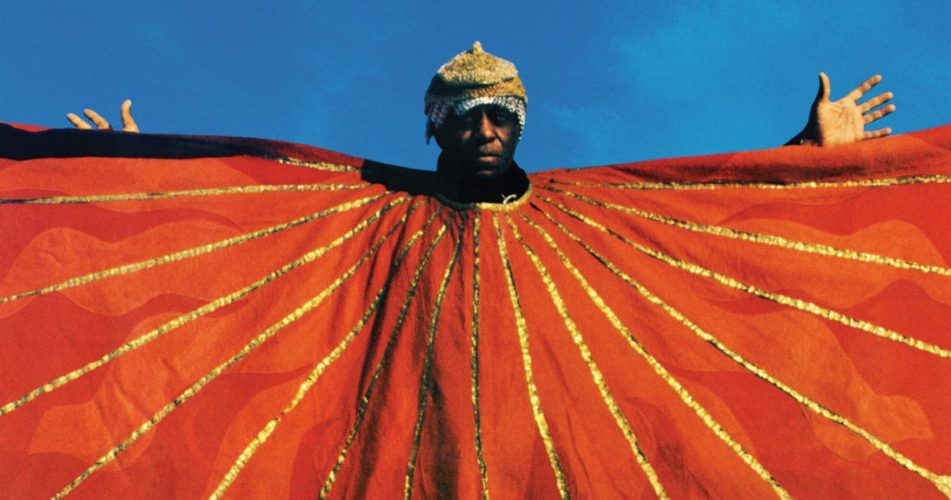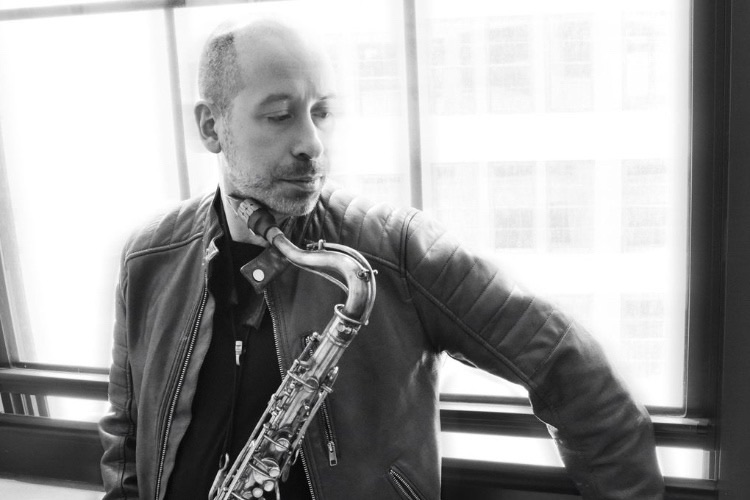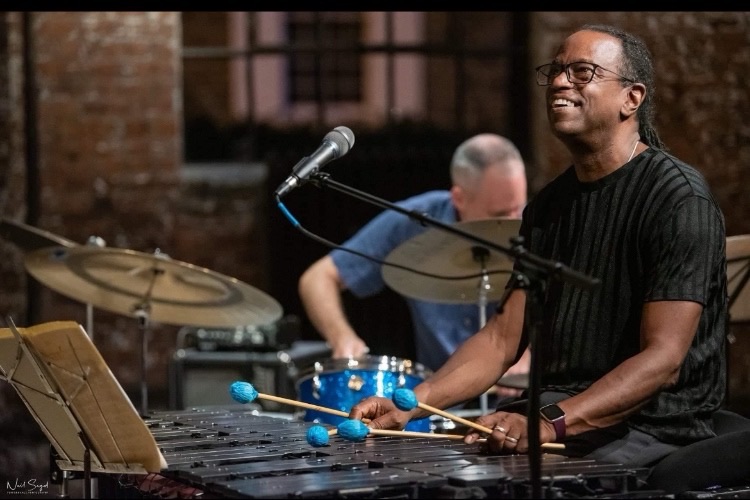Traveling the Spaceways: Sun Ra Arkestra’s ‘Swirling’ and M’Lumbo and Jane Ira Bloom’s ‘Celestial Mechanics’
|
Getting your Trinity Audio player ready...
|
Sun Ra was born on the planet Saturn sometime presumably in the early 20th Century. Some historians mistake him for a gifted pianist named Herman Poole “Sonny” Blount, who was born in Birmingham, Alabama in 1914. In reality, he was the first great composer born on another planet to came to earth with the mission of preaching peace. As the man himself stated- “Any name that I use other than Ra is a pseudonym.” Although not native to our world’s music, throughout his career, he often echoed it all, from ragtime to swing to untethered expression using the most modern electronics of the era. Although he returned to his home nearly three decades ago, his legacy continues to loom large. Countless contemporary albums make this influence clear. However, two excel in this endeavor: The Sun Ra Arkestra’s Swirling (Strut, 2020) and M’Lumbo and Jane Ira Bloom’s Celestial Mechanics (Ropeadope, 2020).
Ra first formed the Arkestra as his large ensemble outfit in the mid-1950s. By this time, the big band concept had been thoroughly explored by artists ranging such as Duke Ellington or Count Basie. But this group was different. Gone were the tuxedos in favor of exotic costumes and headdresses. And the sound; the sound was like no other before. Compositions by the leader, other members, and even covers of more popular tunes were somehow simultaneously ancient yet disruptively modern, a new aesthetic for concepts stereotypically avant-garde in nature. While critics give much attention to 1959 as the golden year of jazz, far too often overlooked in those discussions is the ground shifting done by that year’s Jazz in Silhouette (Saturn, 1959). The many succeeding releases, while influential on other artists, are also often not given their due. Upon Ra’s departure, the group found a leader in John Gilmore and then Marshall Allen, both saxophonists with long careers with the group. At age 96, Allen is still in charge and seems to have more raw energy than most even seventy years his junior.
With Swirling, their first studio album in 20 years, the Arkestra continues to find ways to explore their founder’s compositions and bring new life to them. The release’s first single, “Seductive Fantasy” turns a low tempo extended piece with occasional splashes of fury into an organized march led by the late great Danny Ray Thompson’s beating baritone sax around which other horns and synthesized sounds swirl as they advance forward.
Though originally on Interstellar Low Ways (Saturn, 1966), “Rocket No. 9” is best known from the classic Space is the Place (Blue Thumb Records, 1973). This most recent version is in some ways inverted on Swirling. Acoustic piano replaces keyboards and synthesizers as Allen’s EWI continues to interject a taste of the unknown. Repeated chants are abandoned to allow more space for Tara Middleton’s vocals to weave between the horns. In the process, the new arrangement seemingly makes its message more realistic. For a time in which manned missions to Mars are planned, the idea of a rocket ship to Venus seems to be on the near horizon, not science fiction, and the more “grounded” approach emphasizes this well without sacrificing its eclecticism.
But not all of the tracks are reimaginings of prior recordings by its founder. The title track, a slow piano blues that turns into an off-kilter swing is technically not written by Ra at all. Considering it is penned by Allen who has performed with the group for more than sixty years, it fits unsurprisingly well. Perhaps more interesting is the lost piece “Darkness.” During his time on earth, Sun Ra recorded almost each of the group’s rehearsals to tape. After revisiting these archives, Allen stumbled upon the composition, which had never been officially released or publicly performed by the Arkestra. While its origins date back, it is, in many ways, modern in approach. It is a creative way to end a more gospel-based rendition of “The Sky is a Sea of Darkness,” originally from one of Ra’s more esoteric quartet outings, Disco 3000 (Saturn, 1978).
The Arkestra’s perseverance and evolution confirm Ra’s continuing importance to the group and music generally. Enter M’lumbo’s pairing with Jane Ira Bloom. The former is a band that has explored the outer edges of rock music since the mid-1980s; the latter a soprano saxophonist who has been a pioneer in the use of live electronics and movement in jazz. The two have collaborated several times over the years but Celestial Mechanics is their first complete album together.
M’Lumbo and Bloom share a general emphasis on space with Ra. In some ways, however, they can be seen as approaching the unknown from an opposite perspective. While Ra was an outsider visiting earth, one senses this band is instead exploring our continued spreading of radio waves through space. Their use of standards and pop music further underscores this impression. Throughout his career, Ra would frequently transform these types of songs, including Disney themes and a soundtrack for Batman, into new creations. M’Lumbo and Bloom do so as well with Monk’s “Crepuscule with Nelly,” and the themes to Hawaii Five-O and Sesame Street. The way these are approached, however, seemingly mimic radio waves continuing outward. In every case, fragments of the original remain while the surroundings change to provide new perspectives. This is arguably best seen on “Rock Around the Clock Remix 2020” where the Bill Haley classic is deconstructed and mixed with bells and a wide array of samples such as dialogues, cuckoo clock chimes, and synthesizers.
The originals are no less ambitious. “I Am the Musical Scale of Today” merges spoken word, moody piano chords, samples of 1950s bop, free sax solos, screeches, Headhunters-era Herbie Hancock, and George Gershwin’s “Rhapsody in Blue” are fused into a unique whole. “Yes, We Can Remix 2020” modifies speeches by Presidents Obama and Trump to find their rhythmic cadences and form a rough shell of a song that is seemingly filled with improvisation. In both cases, the band mirrors Ra’s longstanding approach of pulling from different ideas and approaches. That is not to say that other influences – heavy metal, hip hop sampling techniques, and even On the Corner era Miles Davis appear throughout – are not present. However, the influence of Ra remains undeniable.
Whether his band or another, the legacy of the great composer from Saturn continues to endure and guide future generations. The freedom inherent in his art leaves enough room for others to put in their own concepts and push their ideas into new realms, new unmarked territories. Space is the Place.
Swirling is now available on Strut Records
Celestial Mechanics is out now on Ropeadope Record
Swirling
Tracklist: 1. Satellites Are Spinning / Lights on a Satellite; 2. Seductive Fantasy; 3. Swirling; 4. Angels and Demons at Play; 5. Sea of Darkness/Darkness; 6. Rocket No. 9; 7. Astro Black; 8. Infinity/I’ll Wait for You; 9. Unmask the Batman; 10. Sunology; 11. Queer Notions; 12. Space Loneliness; 13. Door of the Cosmos/Say.
Personnel: Marshall Allen (alto saxophone, EVI), Knoel Scott (alto saxophone), James Stewart (tenor saxophone, flute), Danny Ray Thompson (baritone saxophone, flute), Michael Ray (trumpet), Cecil Brooks (trumpet), Vincent Chancey (French horn), Dave Davis (trombone, vocals), Farid Barron (piano), Dave Hotep (guitar) Tyler Mitchell, (bass), Wayne Anthony Smith, Jr. (drums), Elson Nascimento (surdo drums, percussion) Stanley “Atakatune” Morgan (congas), Tara Middleton (vocals, violin).
Celestial Mechanic
Tracklist: 1. Wyoming; 2. All This is True/Brainspotting Live in Concert; 3. Riot of the Glands; 4. Death Valley Sunset Remix 2020; 5. Time Square/The Most Fantastic Machine Live in Concert; 6. Unconscious Forces Remix 2020; 7. I am the Musical Scale of Today Live in Concert; 8. Rock Around the Clock Remix 2020; 9. Facetube Live in Concert; 10. Crepuscule with Nellie Remix 2020; 11. Hawaii Five-O Remix 2020; 12. Lesbian Techno; 13. Yes, We Can Remix 2020; 14. Grand Funk Railroad Live in Concert; 15. Time Square Remix 2020; 16. It Live in Concert Remix 2020; 17. The Most Fantastic Machine Remix 2020; 18. Mister Johnson; 19. Terrible Days of the Phonograph Remix 2020; 20. Drivin’ Along in Radioland Remix 2020; 21. This is the Other Place/Always Looking Forward to Tomorrow Live in Concert; 22. Seasame Street Remix 2020.
Personnel: Robert Jordan Ray Flatow-(electronic keyboards, key bass, suitcase symphonetta, ectoplasmic radio, percussion, voice), Lord Cecil Young (trumpet, percussion), Jane Ira Bloom (soprano saxophone, electronics), Vincent Veloso (alto saxophone, flute, piano, electronic keyboard), Paul-Alexandre Meurens (tenor saxophone, flute, bass clarinet, oscillator, electric guitar, ectoplasmic radio), Brian O’Neill (electric guitar, ectoplasmic radio, guitar synth, percussion), Jaz Sawyer (drums), Dehran Duckworth (congas, percussion), Maureen ‘Mo’ O’Connor (congas, percussion), Page Hamilton (electric guitar), Andrew Hadro (baritone saxophone), Emanuel Ruffler (ectoplasmic radio, electronic keyboard), James McClean (electronic keyboard, ectoplasmic radio), Eduardo Guedes (percussion).




One thought on “Traveling the Spaceways: Sun Ra Arkestra’s ‘Swirling’ and M’Lumbo and Jane Ira Bloom’s ‘Celestial Mechanics’”